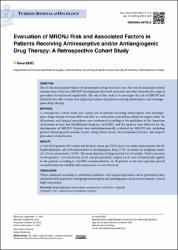| dc.contributor.author | Ekici, Ömer | |
| dc.date.accessioned | 2023-11-15T12:33:10Z | |
| dc.date.available | 2023-11-15T12:33:10Z | |
| dc.date.issued | 2023 | en_US |
| dc.identifier.citation | EKİCİ, Ö. (2023). Evaluation of MRONJ Risk and Associated Factors in Patients Receiving Antiresorptive and/or Antiangiogenic Drug Therapy: A Retrospective Cohort Study. Turkish Journal of Oncology/Türk Onkoloji Dergisi, 38(1). | en_US |
| dc.identifier.issn | 1300-7467 | |
| dc.identifier.uri | https://dx.doi.org/10.5505/tjo.2022.3359 | |
| dc.identifier.uri | https://hdl.handle.net/20.500.12933/1767 | |
| dc.description.abstract | OBJECTIVE Due to the increased prevalence of antiresorptive drugs in recent years, the risk of medication-related osteonecrosis of the jaws (MRONJ) development after tooth extraction and other dentoalveolar surgical procedures has increased significantly. The aim of this study is to investigate the risk of MRONJ and related factors after routine oral surgical procedures in patients receiving antiresorptive and antiangiogenic drugs therapy. METHODS A retrospective cohort study was carried out in patients receiving antiresorptive and antiangiogenic drugs therapy between 2019 and 2021 at a university’s oral and maxillofacial surgery clinic. In all patients, oral surgical procedures were performed according to the guidelines of the American Association of oral and Maxillofacial Surgeons (AAOMS), and the patients were followed for the development of MRONJ. Patients were multidimensionally evaluated for MRONJ risk, including patient-related general-systemic factors, drug-related factors, local anatomical factors, and surgical procedure-related factors. RESULTS A total of 76 patients (60 women and 16 men); mean age (59.23 years) was under antiresorptive (86.8% bisphosphonates, and 6.6% denosumab) or antiangiogenic drug (5.3%) treatment for malignant tumor (21.1%) or osteoporosis (78.9%). The mean duration of drug received was 42 months. Tooth extraction (n=66 patients), cyst enucleation (n=6), and pre-prosthetic surgery (n=4) were atraumatically applied to the patients according to AAOMS recommendations. In all patients in the post-operative period wounds healed uneventfully and osteonecrosis was not observed. CONCLUSION When conducted according to established guidelines, oral surgical operations can be performed safely and predictably in patients undergoing antiresorptive and antiangiogenic medication treatment, even in high-risk patients. | en_US |
| dc.language.iso | eng | en_US |
| dc.publisher | Ali Cangül | en_US |
| dc.relation.isversionof | 10.5505/tjo.2022.3359 | en_US |
| dc.rights | info:eu-repo/semantics/openAccess | en_US |
| dc.title | Evaluation of MRONJ risk and associated factors in patients receiving antiresorptive and/or antiangiogenic drug therapy: A retrospective cohort study | en_US |
| dc.type | article | en_US |
| dc.department | AFSÜ | en_US |
| dc.contributor.institutionauthor | Ekici, Ömer | |
| dc.identifier.volume | 38 | en_US |
| dc.identifier.issue | 1 | en_US |
| dc.identifier.startpage | 112 | en_US |
| dc.identifier.endpage | 119 | en_US |
| dc.relation.journal | Türk Onkoloji Dergisi | en_US |
| dc.relation.publicationcategory | Makale - Ulusal Hakemli Dergi - Kurum Öğretim Elemanı | en_US |
















